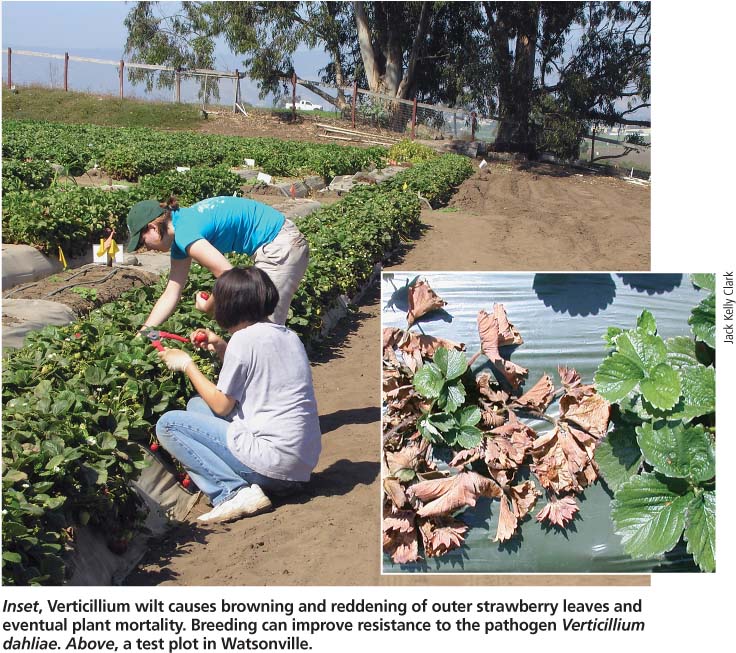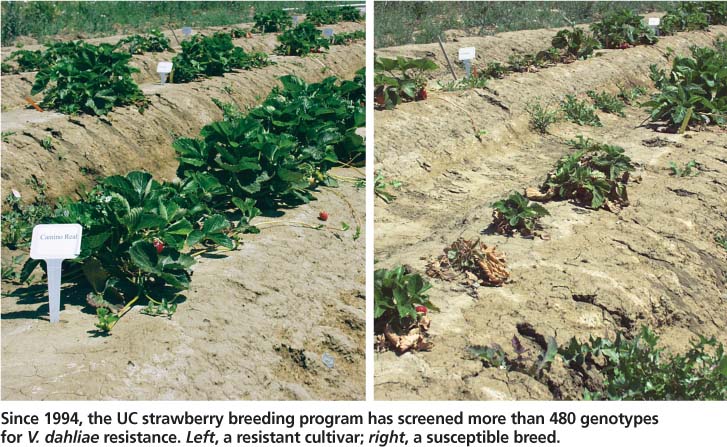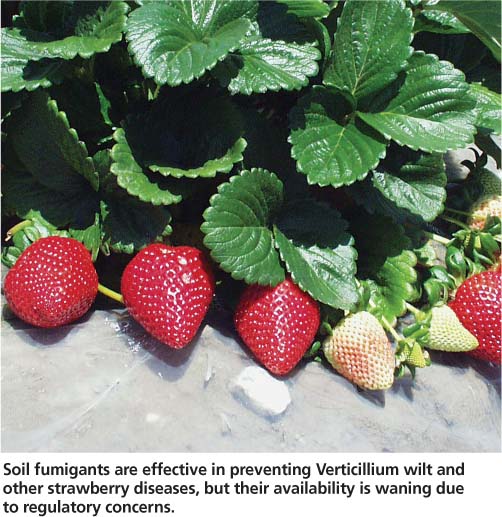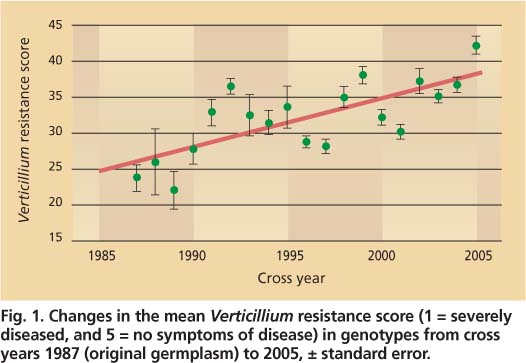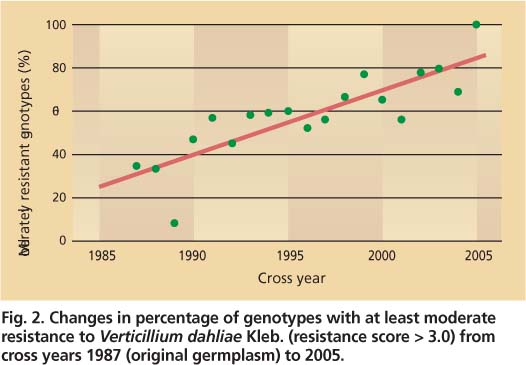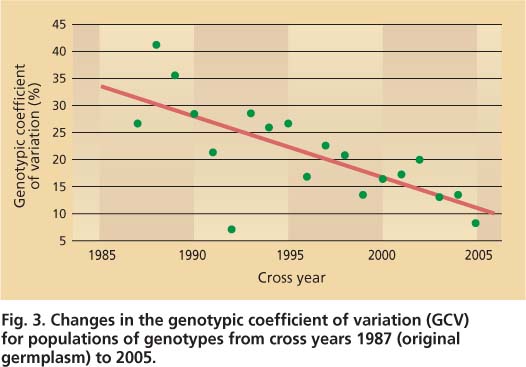All Issues
Strawberry breeding improves genetic resistance to Verticillium wilt
Publication Information
California Agriculture 64(1):37-41. https://doi.org/10.3733/ca.v064n01p37
Published January 01, 2010
PDF | Citation | Permissions
Abstract
Since 1994, more than 480 genotypes from the UC strawberry breeding program have been screened for resistance to Verticillium dahliae Kleb., an important soil pathogen of strawberry. Genotypes for parents of subsequent generations have been chosen using a multiple-trait strategy that incorporates their Verticillium resistance rating. This selection strategy has increased resistance scores for the parents by 60%, and increased the percentage of moderately resistant genotypes from 35.0% in the original germplasm to 78.5% in those used as parents for the most recent crosses. Selection has reduced genetic variation for the resistance score, and genotypic coefficients of variation (GCV) decreased in the breeding population from 34.4% to 11.6% from 1994 to 2008. Inspection of genotypic scores suggests that the GCV change pattern may not be due to a scarcity of variation, but rather to limitations in the detection test. Our results suggest the need for broader testing of the more-resistant types identified in naturally infested soils and improved understanding of resistance mechanisms. Ultimately, this work seeks to provide a Verticillium-resistant cultivar to growers if access to effective soil fumigants becomes more limited.
Full text
Prior to the widespread use of soil fumigants, Verticillium dahliae Kleb. was considered among the most important pathogens affecting commercial strawberry production in California (Thomas 1932). Plantations established in infested soils often suffered 50% or greater mortality (Thomas 1932; Wilhelm and Koch 1956), and wilt from this pathogen continues to be a major concern where strawberries (Fragaria x ananassa Duch.) are managed in perennial planting systems (Wilhelm and Paulus 1980; Maas et al. 1989; Paulus 1990). Breeding for resistance has been an important strategy for minimizing damage caused by V. dahliae in strawberry for several decades, and genetic variation for resistance to this pathogen has been demonstrated in many breeding populations (Bringhurst et al. 1966, 1968; Maas et al. 1989; Shaw et al. 1996).
Inset, Verticillium wilt causes browning and reddening of outer strawberry leaves and eventual plant mortality. Breeding can improve resistance to the pathogen Verticillium dahliae. Above, a test plot in Watsonville.
The University of California (UC) strawberry breeding program was initiated in 1930, and its goal since initiation has been to release cultivars specifically adapted to California production environments. In part due to concerns about the continued availability of effective soil fumigants, researchers in the UC strawberry breeding program began to develop a field-based resistance screening method in 1992 (Shaw et al. 1996; Shaw et al. 1997; Gordon et al. 2005), and an ongoing resistance evaluation program has been conducted for this disease since 1994.
Preliminary experimental results demonstrated substantial genetic variation for an overall low level of resistance to V. dahliae in the UC breeding population (Shaw et al. 1996). Researchers also verified that resistance to the pathogen in this population has polygenic inheritance, is conditioned by both additive and dominance genetic effects, and that genotypes with high resistance were rare in the germplasm at that time. These results suggested that the infusion of non-California germplasm was not needed to obtain genetic progress, but that substantial time and effort would be needed to change the genetic composition of the breeding population and generate Verticillium-resistant strawberry cultivars with adequate frequency.
Strategies to improve resistance
Backcrossing. Two broad strategies have been used to improve genetic resistance to soil disease in crop plants. One common approach is to first identify resistant germplasm and generate highly resistant lines, then backcross the resistance into elite cultivars. This method works well when the inheritance of resistance is conditioned by one or a few genes and the crop-specific breeding system permits backcrossing and self-fertilization for rapid genetic transfer and stabilization. Intensive selection for resistance within the UC germplasm base has resulted in genotypes that exhibit few symptoms following inoculation with V. dahliae (Shaw and Gordon 2003; Gordon et al. 2005; Shaw et al. 2005), and these genotypes have been useful in evaluating selection limits and the mechanisms of resistance within this genetic base (Gordon et al. 2006). However, even asymptomatic plants suffer some yield loss under conditions of high disease pressure (Shaw et al. 2005). Furthermore, due to the intensified focus on resistance in generating these genotypes, they all express substantial deficiencies for horticultural or productivity traits, and as a consequence this strategy has not been successful in generating cultivars that meet the commercial standards required of modern strawberry cultivars in California.
Population improvement. An alternative breeding strategy is to obtain incremental increases in resistance through population improvement, by inclusion of V. dahliae-screening results in a multiple-trait selection system to choose the parents of elite breeding populations. This strategy is generally a superior alternative for developing resistance in cross-fertilized crops such as strawberry. This system is especially useful when inheritance of the resistance is polygenic, or determined by many genes, and backcrossing systems are consequently less effective. Furthermore, with multiple-trait selection, Verticillium resistance is considered as one among the many characteristics required to render a cultivar useful to strawberry growers in commercial production. This selection system permits flexibility in the relative weighting of selection intensity for resistance and horticultural traits, and can result in cultivars of balanced commercial utility. Backcrossing methods for resistance can be combined with multiple-trait selection for horticultural traits, but this strategy is generally most effective for inbred crops.
UC has conducted strawberry breeding continuously since 1930 (Bringhurst and Voth 1960), and the improvement of traits important for commercial productivity has been substantial (Shaw and Larson 2008). The choice of parents for the population-improvement component of this program has depended in part on resistance to important pathogens, and the longest continuous screening effort has been dedicated to Verticillium dahliae Kleb. resistance. This study reports on progress in developing resistance to V. dahliae within the UC strawberry breeding program obtained through parent selection and population improvement since 1994.
Evaluating resistance
Between 1994 and 2008, 481 genotypes from the UC strawberry breeding program were screened for resistance to V. dahliae. This sample included 461 advanced selections, genotypes identified with superior characteristics and which might either serve as parents for future generations or eventually be released to growers as cultivars. These selections were obtained from controlled crosses conducted over 18 years (1988 to 2005), with 11 to 49 genotypes from each cross year. Twenty genotypes were tested from the original germplasm base present prior to 1988. Strawberry breeding proceeds with overlapping generations, but the yearly changes in resistance for the genotypes used as parents from 1988 to 2005 provided a reliable empirical index of genetic progress for this population.
The advanced selections tested for resistance in each trial year included those genotypes considered most promising based on their performance in fruiting trials conducted at either the UC South Coast Research and Extension Center near Irvine, Calif. (33°41’ N, 117°43’ W), or the Watsonville Strawberry Research Facility (36°54’ N, 121°48’ W). The genotypes included from any cross year had not been evaluated for resistance prior to their selection for horticultural and productivity traits, and they provide a representative sample of the variation for resistance in that cohort. Changes in resistance parameters over time reflect the outcome of including resistance in the multitrait selection strategy for prior parent choice.
Selection intensity. The selection intensities — which reflect the relative importance of the selected trait — applied to the improvement of Verticillium wilt resistance during the study period are impossible to quantify with precision, but the genetic progress reported here results from two sources. First, the most susceptible genotypes (those with resistance scores less than 2.0) usually were eliminated entirely, and the participation of moderately susceptible genotypes (those with scores between 2.0 and 3.0) as parents was limited to a few crosses. Moderately susceptible genotypes were included if they expressed outstanding horticultural characteristics, but they usually served as parents in crosses for just one year. Second, individual genotypic selections were made with knowledge of parental resistance scores, and fewer genotypes were retained from crosses expected to contain high frequencies of susceptible individuals.
Since 1994, the Uc strawberry breeding program has screened more than 480 genotypes for V. dahliae resistance. Left, a resistant cultivar; right, a susceptible breed.
Resistance evaluations. All Vertzcillzum-resistance evaluations were conducted following root-dip inoculations (Shaw et al. 1996). Runner plants from each tested genotype were immersed in an aqueous suspension of 1.0 × 106V. dahliae spores per milliliter. All evaluations were conducted at the Wolfskill Experimental Orchard near Winters, Calif. (38°30’ N, 121°59’ W). The inoculum included spores from one to three isolates originally obtained from symptomatic plants found in commercial production fields in California (Gordon et al. 2006). Each genotype was represented by two plots of five inoculated runner plants per trial year; two noninoculated plants of the test genotype were placed adjacent to each plot, and disease ratings were made relative to these control plants. Plots were distributed between two replicates, and each year's trial comprised a randomized complete block design. Inoculated plants and controls were established in the field from Oct. 5 to 18 each year. Many of the individual genotypes, 204 of the 481, were tested in more than one year, and the average number of test years per genotype was 1.7. In general, genotypes under consideration for release as commercial cultivars were tested with greater replication over years, and these superior genotypes were also heavily represented in crosses conducted to facilitate population improvement.
Genotypes were evaluated in the spring following inoculation, by rating plants for symptoms of Verticillium wilt on a scale of 1 to 5, where 1 = severely diseased and 5 = no symptoms of disease (comparable in appearance to corresponding noninoculated controls). Individual plots were evaluated four to seven times in each trial year at approximately 3-week intervals beginning with the first symptoms on susceptible genotypes (Feb. 28 to May 5), and a combined score was obtained as the arithmetic mean of scores for all dates (Shaw et al. 1996). An average resistance score was calculated for each genotype and year combination as the mean for the two replicates.
Resistance scores. Variation in resistance scores over trial years due to environmental factors — such as differences in ambient temperature, isolate source or inoculum quality — was confounded with genetic differences generated due to selection over years. Several of the genotypes were tested in most of the evaluation years, and the examination of these samples demonstrated relatively small yearly fluctuations in genotypic score. For example, on a resistance scale of 1 to 5, the relatively susceptible cultivar Camarosa had an average score of 2.52 and a standard deviation of 0.46 over all years, and the moderately resistant cultivar Camino Real had an average score of 4.25 and a standard deviation of 0.41 for trials conducted in 11 of the 15 years. This suggests that more than two-thirds of the samples will vary by no more than about 0.435 scoring units from year to year. The effect of trial year was not considered further, but is reflected as part of the error variation in our analyses.
Changes in the Verticillium resistance scores due to selection were evaluated by first calculating a composite genotypic score as the average for each genotype over all trial years in which it was tested, then plotting and regressing these composite scores by cross year. The 20 genotypes from the original germplasm sample were considered representative of a base population present in 1987, and are included as such in plots and regression analyses. The average resistance scores were further resolved by calculating the percentage of genotypes in each cross-year population with a composite score greater than 3.0, and thus exhibiting at least moderate resistance. The percentages calculated for each cross year were plotted and treated by regression analysis as described for the resistance scores.
Soil fumigants are effective in preventing Verticillium wilt and other strawberry diseases, but their availability is waning due to regulatory concerns.
Genetic variation. Successful directional selection for any polygenic trait can lead to a reduction of genetic diversity, as favorable genetic combinations are fixed in the breeding population. Genetic variation was evaluated in our experiment by obtaining estimates of genotypic variance components using the restricted maximum likelihood option of the SAS procedure VARCOMP (SAS 1999). To monitor changes in genetic variation for resistance due to selection, the component of variance due to genotypes was first estimated for each cross year, then transformed to a genotypic coefficient of variance (GCV) to correct for scale effects (Falconer and Mackay 1996) as:
where σ2g is the genotypic variance estimate for the Verticillium resistance score and is the mean resistance score in any cross year.Coefficients of variation are recommended to avoid scale effects for comparing variation among populations that differ in mean (Snedecor and Cochran 1980), as might be expected for a trait in a population under recurrent selection. Trends throughout the experimental period were analyzed by plotting and regressing each estimated GCV by cross year. Trial year was ignored in this analysis, and replicates were considered as completely random; this strategy was adopted to avoid confounding variance due to trial year with that due to differences among genotypes.
Fig. 1. Changes in the mean Verticillium resistance score (1 = severely diseased, and 5 = no symptoms of disease) in genotypes from cross years 1987 (original germplasm) to 2005, ± standard error.
Fig. 2. Changes in percentage of genotypes with at least moderate resistance to Verticillium dahliae Kleb. (resistance score > 3.0) from cross years 1987 (original germplasm) to 2005.
Analysis of resistance trends
The absence of reliable estimates for selection intensities and the presence of overlapping generations precludes precise determinations of the genetic response; however, the general trends for inclusion of Verticillium resistance in the population improvement program are evident from the steady increase in resistance scores over cross years (fig. 1). Regression of resistance scores for the 481 genotypes on their cross year demonstrated a highly significant increase over time, with b = 0.061 ± 0.007 (F1,479 = 73.1**; ** = statistically significant at the 1% probability level). The predicted change in resistance score from this regression analysis over 18 cross years affected by selection is 1.10 resistance-score units, or a 46.3% improvement over the average resistance score for the original germplasm (
= 2.37 ± 0.19). The observed average resistance score for genotypes from cross years 2003 to 2005, for example those that would serve as parents in the most recent controlled crosses, was = 3.79 ± 0.06, giving a realized difference of 1.42 resistance-score units between the current and original germplasm bases, or a 59.9% increase over the 18 selection years.Selection has had a somewhat larger effect on the fraction of genotypes in the population with at least moderate resistance, defined as a resistance score greater than 3.0 (fig. 2). Regression of the percentage of genotypes with scores above 3.0 on cross year resulted in a highly significant result with b = 2.99 ± 0.47 (F1,17 = 41.1**). Based on this regression result, the predicted change in the percentage of moderately resistant genotypes over 18 years of selection is 53.8%; the observed percentage for cross years 2003 to 2005 (
= 78.5%) was more than double that for genotypes from the original germplasm ( = 35.0%), suggesting that selection had been somewhat more effective at eliminating highly susceptible genotypes than predicted by linear analysis.The selection response since 1994 has had a substantial effect on the variation for resistance remaining in the breeding population (fig. 3). GCV for resistance score decreased in the breeding population from 34.4% in the original germplasm to 11.6% for genotypes in the 2005 cross year. Regression of the estimated GCV on cross year demonstrated a highly significant decrease in genetic variation over time, with b = −0.011 ± 0.003 (F1,17 = 17.6**), indicating a reduction in just over 1% of the original GCV per cross year. This reduction might be due to the depletion of genetic variation, and might indicate limits to the development of improved resistance due to further selection. However, the inspection of genotypic scores also demonstrated a concentration of genotypes in recent years with scores near the highest ratings discernible by current testing methods. The pattern of change in GCV may be due to limits in discernment among the more resistant genotypes imposed by the test itself, rather than an absence of variation available for further progress.
Creating superior cultivars
Fig. 3. Changes in the genotypic coefficient of variation (GCV) for populations of genotypes from cross years 1987 (original germplasm) to 2005.
Ultimately, the impact of this genetic improvement will be realized when superior resistance is packaged and utilized commercially in the form of a cultivar that possesses superior horticultural characteristics as well. The response to selection for horticultural traits has been well documented in the UC program. For example, Shaw and Larson (2008) demonstrated improvement of 47% to 140% for yield, fruit size, fruit appearance and fruit firmness in cultivars released over a 47-year period. Similar analysis of these traits in the breeding population from 1992 to 2005, roughly the period of genetic improvement for Verticillium wilt resistance evaluated here, indicates response rates for the same traits 1.7 to 2.6 times the historical rates.
Clearly, the progress for resistance obtained with this selection strategy has not excessively limited the opportunity for horticultural trait improvement. For comparison, the 17 cultivars released from the UC program prior to 1994 had an average resistance score of
= 2.53 ± 0.18, whereas the seven cultivars released after 2001 had scores of = 3.53 ± 0.17. These mean differences reflect responses similar to those obtained in the germplasm as a whole, and indicate that the typical cultivar prior to this program was moderately susceptible, whereas the most recently released cultivars are moderately resistant to Verticillium wilt. Multiple-trait selection strategies could have weighted resistance traits more heavily and horticultural traits less so, with corresponding tradeoffs in selection response.Screening improvements
Our results, especially the last comparison, suggest two areas requiring further research. First, broader testing is needed of the more resistant types identified in this program in naturally infested soils to determine whether resistance outside the range presently observed will be required for adequate performance of cultivars in commercial conditions where V. dahliae is an expected limiting factor. To date, opportunities for such tests have been limited by the common practice of preplant soil fumigation. Soil fumigation maintains soil populations of V. dahliae below levels that are damaging even to susceptible genotypes, and opportunities for widespread testing in naturally infested soil simply do not exist at present. In the immediate future, it is likely that high soil-inoculum levels will continue to be a rarity as long as growers utilize the most effective available fumigants to suppress V. dahliae.
Genotypes with resistance capacity exceeding that already realized may not be required to meet commercial needs in the near future, but they may become essential if and when efficacious fumigants are no longer available. It is not known whether the levels of resistance achieved to date will be sufficient to sustain production in the worst-case scenario. Also, one limitation of the multiple-trait and population-improvement strategy is that it tends to fix the alleles favorable for resistance only after many generations. Continued selection within the breeding population is still needed to eliminate the moderately susceptible genotypes that do emerge through segregation, regardless of potential changes in fumigation practices.
Second, if resistance outside the range of that detectible by present screening methods is needed, then a better understanding of the mechanism of resistance may facilitate the development of screening procedures that will expand the range of discrimination beyond that currently available. Genetic variation required for developing such genotypes may or may not exist within the currently available germplasm, but there is no reason to suspect its absence until more sensitive tests are developed Breeding for resistance to V. dahliae over 18 cross years has yet to resolve the problem completely, but our results suggest that the multiple-trait selection strategy employed to date has generated substantial improvement without compromising gains for the myriad other characteristics of importance in a commercial strawberry cultivar.



